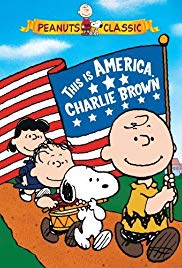THIS IS AMERICA CHARLIE BROWN
THE GREAT INVENTORS
Subject: U.S./1865 – 1913; Science-Technology
Ages: 8 – 11
Length: 24 minutes
SNIPPET MENU
Using the Snippet in Class:
LEARNING OUTCOMES/OBJECTIVES
“The Great Inventors” will introduce children to Edison, Bell and Ford and to the way in which our lives have been changed by the light bulb, the phonograph, the telephone, and the automobile.
PARENTING POINTS
Your child will be intrigued to learn that this cartoon has some relationship to real events. Review the Helpful Background section and talk about the inventors portrayed in this film. You will not be able to cover everything but do the best you can. Immediately after the movie, or at odd times over the next week (for example at the dinner table or in the car on the way to school) bring up some of the Discussion Questions, starting with the Quick Discussion Question in the sidebar. Don’t worry if you can only get through a few questions. Just taking the film seriously and discussing it is the key. Allow your child to watch the movie several times and continue to ask and help him or her answer more discussion questions.
DESCRIPTION OF SNIPPET
The Peanuts gang reports on the burst of inventiveness in the U.S. between 1870 and 1900. The focus is on Alexander Graham Bell, Thomas Edison and Henry Ford.
It is not necessary for children to be familiar with the Peanuts characters to enjoy this film.
HELPFUL BACKGROUND
To enhance the educational value of this film, parents need only watch the film with their children and comment on two or three of the points made in the film. The additional helpful background is set out below.
Edison was granted 1,093 patents, more than any other individual. His inventions include: the incandescent light bulb; the phonograph; the motion picture camera and projector; the alkaline storage battery; the dictating machine; numerous improvements to the telegraph; the carbon-button transmitter that is still used in telephone speakers and microphones; the mimeograph; the fluoroscope and many more.
Alexander Graham Bell (1847 – 1922) was granted 18 patents in his own name and 12 patents as a collaborator with others. In addition to the telephone, he invented a hydrofoil and improved the telegraph. His first invention, completed when he was just 11 years old, was a device for cleaning wheat.
Bell’s mother was deaf and he married a deaf woman. It was Bell who suggested that the family of Helen Keller employ a teacher of the deaf. This teacher, Anne Sullivan, unlocked the secrets of communication for Helen. When Helen Keller learned to write, she began a correspondence with Bell which lasted for years. While Bell tried to help deaf people become educated and get along in life, he had a bitter rivalry with one partially deaf person, Thomas Edison.
Bell was a co-founder of the National Geographic Society. For many years he published the magazine “Science,” an influential journal for the scientific community. “Science” is still published today.
Bell was not adept at making things with his hands. For this, he relied upon his long-time assistant Thomas Watson. Bell had the ideas and Watson put them into physical form.
As a young man, Henry Ford (1863 – 1947) worked as a mechanic for one of Thomas Edison’s companies. When the famous inventor visited the company where Ford worked, the supervisor introduced Ford as a young man who had designed a gasoline automobile. Edison asked Ford to explain how the car functioned and afterward urged Ford to “keep at it.” Ford never forgot this encouragement. When Ford became successful he bought a vacation home near Edison’s retreat in Fort Myers, Florida. When Edison suffered business reversals and was short of cash, Ford contracted with Edison to develop batteries for Ford automobiles. The two men became close friends.
In the early 1900s the automobile was thought of, in part, as a safety device. Horses are prone to injure or kill their riders by throwing them to the ground. Before the advent of the automobile this happened so frequently that it was a serious public health problem. The automobile is much more reliable than the horse and initially the rate of injuries went down. However, as speeds and traffic increased, the automobile accidents became a major source of injuries.
Ford made mistakes later in his career. He refused to improve the Model T and it eventually lost market share to other companies which continually improved their cars. When the Model T first became a success, Ford treated his workers well, increasing wages, establishing an eight hour work day, and providing other benefits. However, during the Great Depression, Ford drastically reduced wages. When his workers tried to organize unions, Ford resisted, using unfair tactics such as employing spies and thugs to intimidate the workers. The Ford Motor Company was the last major auto maker to recognize the United Auto Workers Union. Ford was also anti-Semitic and very late to see the menace of Nazism. As a pacifist, he opposed U.S. entry into World War II, but after Congress declared war, the Ford Motor Company was an important asset in war production. Ford’s deficiencies, while of serious concern, cannot erase the tremendous contribution that he made in producing low cost reliable automobiles designed for the general public.
STEP BY STEP
Discussion Questions:
1. See Discussion Questions and Projects for Use With Any Documentary.
2. Which invention has changed our lives more: the telephone, the phonograph and its progeny, the light bulb or the automobile?
3. Which of the three inventions, the telephone, the phonograph and its progeny, the light bulb or the automobile, would you be most willing to do without?
4. Who was the greatest inventor of all time? Why?
5. Is there an inevitable logic to innovations? In other words, would any of the following have necessarily been invented by someone at sometime had they not been invented by Bell, Edison or Ford: the assembly line, the light bulb, the phonograph, the telephone, the telegraph?
Assignments, Projects, and Activities
See Discussion Questions and Projects for Use With Any Documentary.
This Snippet was last updated on December 17, 2009.

Snippet Menu:
Learner Outcomes/Objectives
Parenting Points
Description of the Snippet
Helpful Background
Using the Snippet in Class:
QUICK DISCUSSION QUESTION:
Describe what life would be like without the telephone, without recordings of music, without the light bulb, and/or without the automobile.
Suggested Response:
In the discussion about this question, help children explore the ramifications of the lack of these inventions into many different areas of life: work, leisure, transportation, medicine, different stages of life, different cultures, etc.
For more information about Thomas Edison, see Learning Guide to “Edison: The Wizard of Light”.
MOVIES ON RELATED TOPICS:
This film is part of a series entitled This is America Charlie Brown. Other films in the series include: The Birth of the Constitution, The Mayflower Voyagers, The Smithsonian and the Presidency, The Building of the Transcontinental Railroad, The Music and Heroes of America and The Wright Brothers at Kitty Hawk.
BUILDING VOCABULARY:
gymnasium, intercollegiate, refrigerated, “horseless carriage,” modulating, “sound waives,” “electrical impulse,” transmit, experiment, “highly irregular,” “beaten track,” diaphragm, vibrate, “newfangled contraption,” impression, “mass produce,” afford, “average American,” “assembly line,” chassis.
Search Lesson Plans for Movies
Get our FREE Newsletter!
* we respect your privacy. no spam here!




